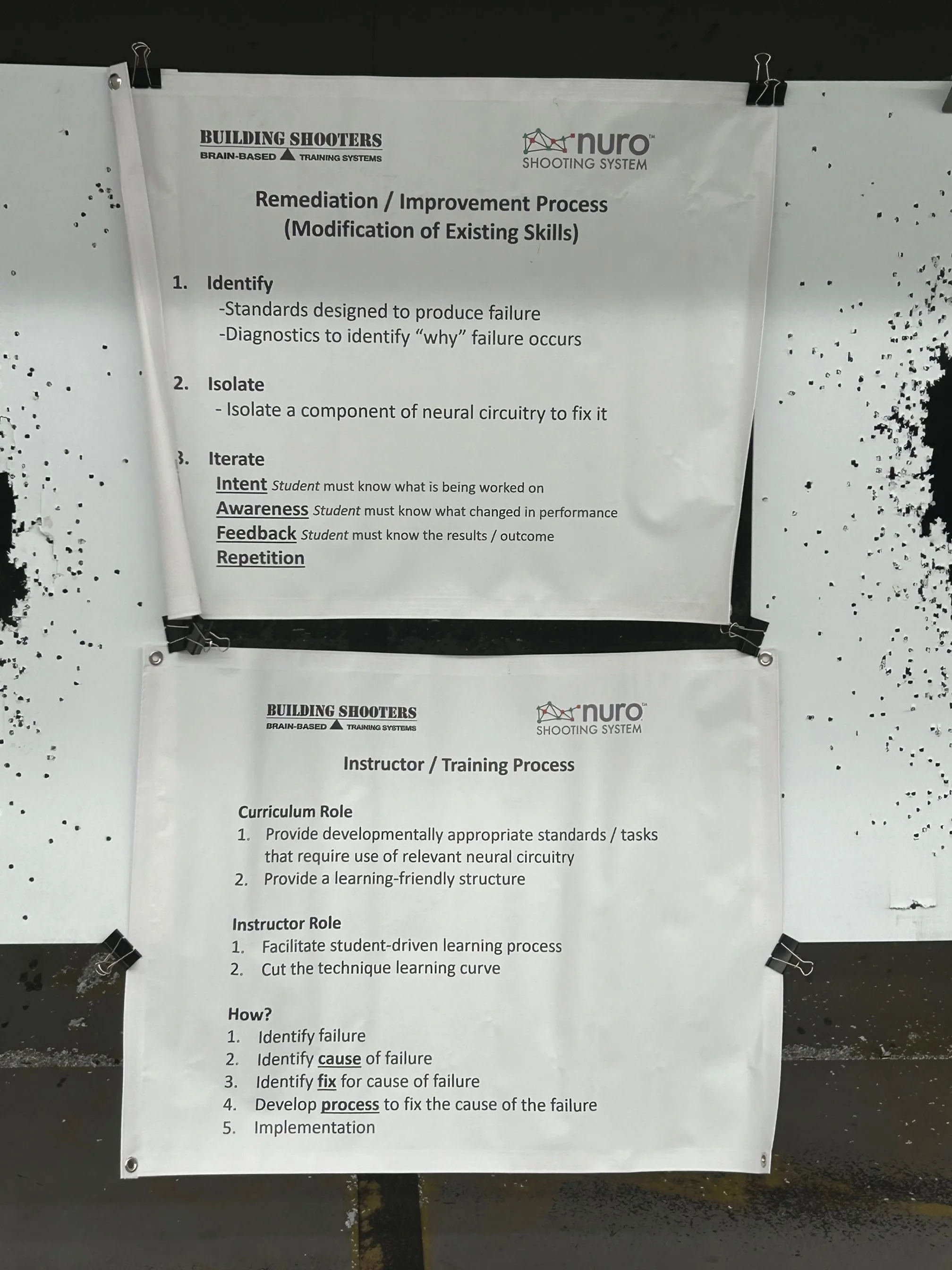AAR - BUILDING SHOOTERS
Overview - From September 17-20, 2024 I attended the Building Shooters seminars “Understanding the Terrain: An Overview of Brain-Based Tactical Training Design” followed by “Tactical Vision and Surgical Marksmanship”. The classes were held in Gilbert, AZ at the Gilbert Public Safety Training Facility. The classes were attended by members of the Gilbert, AZ police academy training staff, two members of the Phoenix PD SAU (their version of SWAT), some private security personnel, and an industry rep from Leupold.
VENUE – Gilbert is a pretty rich area, and their training facility reflects that. The classroom and range facilities (indoor) were very nice and close to hotels and restaurants.
GEAR – I wore my standard belt kit. Everything worked as expected.
GUNS – I shot my G45 with ACRO. No weapons or optic issues during the class.
POI – “Understanding the Terrain” was a very interesting two days. I’ve been nerding out on how we learn for the past few years and this seminar dove tailed nicely into the other reading that I have done on the topic. How the brain stores and then accesses information is a topic of great interest to me in my role as a trainer. How that can change under stress is also something that I view as very relevant for us.
The seminar dove into cognitive architecture, neuroplasticity, stress processing, relational vs. episodic memory and several other topics that had been primed with prereading that had been sent out a few days before the seminar began. After discussing how all that fits together, the discussion moved on to what that means for the tactical training world.
One of the key concepts that was foundational to the discussion is the idea that neurons that fire together, wire together (Hebbian learning). What does this mean from a training perspective?
If every time I draw my gun, I point it at a target> Every time I point my gun at a target, I fire two rounds > Every time I finish firing two rounds, I holster my gun. I’m building a neural circuit that could *force* me to draw, fire two rounds, and reholster… even if that isn’t the appropriate response. I’m sure we’ve all heard the stories of the police officer killed in a gunfight who was found with his revolver brass in his pocket because that was how he had always done it on the range.
So a lot of the take aways in the classroom and on the range were about building “off-ramps” into your training. Very simply, sometimes draw to a ready instead of drawing and pointing at the target. Sometimes point the gun and issue a verbal challenge or command instead of shooting right away. Etc.
For this class this was accomplished via the NURO device, a kind of laser shot timer that can project red or green lasers onto a target to initiate a response. There were also lenses that could be screwed over the emitter so that the laser projected the image of a hand or a gun (Mr. Saloman made it a point to mention that something similar could be done with handheld laser pointers if you were so inclined).
The idea is that you can brief students that red laser on a target means lethal threat, green laser is an unknown, red and green lasers together is a threat that doesn’t mean lethal criteria and should be challenged at gun point. Or anything else you make up. The point is that you must react to what you’re seeing and make decisions, rather than just banging away on the range doing known courses of fire.
The criteria that was established for the course was a 3” circle cut out high in the chest as the acceptable hit area, a 1.5sec expectation for first shot, and no shots over .5sec after the stimulus went away.
The second class “Tactical Vision and Surgical Marksmanship” was rough. It seemed like a class where the instructor had a lot of interesting ideas but hadn’t put them together in a coherent class yet. The classes started off with the stated goal that it was going to be about analyzing shooter’s performance and coaching them to improve. Not exactly what the course description outlines but okay. Still applicable.
Unfortunately, we only spent about an hour actually working with another shooter in the class as a coach. There were some interesting outlines presented for structuring a program (built around a 6 month police academy so not very applicable to us). A lot of time was eaten up repeating information from the first two days for people who only came to the second class and then shooting drills with the Neuro in groups of three, which made for a lot of down time and wasted range space.
In it’s current form, I wouldn’t recommend it. Mr. Saloman sent out an email after the class stating that he was very unhappy with the product he presented and apologizing, so I anticipate it will get cleaned up going forward.
LESSONS LEARNED –
I had read Mr. Saloman’s books Building Shooters and Hitting in Combat prior to attending the class. A lot of the information covered in the class is covered in more detail in the books but the opportunity to ask clarifying questions and hear the information was a good refresher. There was also a lot of overlap with John Hearne’s class Who Wins, Who Loses and Why and with adult learning and human performance books like Thinking Fast and Slow, The Art of Learning, The Talent Code, The Inner Game of Tennis, Talent is Overrated, Make it Stick, Etc. The interesting this about this seminar is the specific application of some of that research to tactical training.
Two take aways from the classes,
First was shooting into negative space. The USPSA targets we were shooting for most of the class had 3” circles cut out of the high-chest area. The purpose of this (besides, I assume, saving money on targets) is to help train people not to look for hits. A lot of us, me included, tend to want to look over the top of the gun on longer strings of fire to see where we’re hitting. If there isn’t anything to see, there isn’t anything to look for. Just stay in the in the sights and work the trigger. We shot the same accuracy standard with shirts clipped over the front of the target. Again, nothing to see other than the sights. Not a new concept but one I haven’t used much in the past few years.
The second was something that we did for the short time we were coaching each other. Mr. Saloman had everyone use their non-dominant side. Since most of us haven’t spent much time using our non-dominant side when shooting with both hands, that gave the coach things to look at and correct.
OVERALL –
The first seminar was interesting. Heavy on concepts, light on tangibles to take back to a training program that isn’t months long like a police academy, but interesting information. For you guys running your weekly fun-shoots and hitting the range with different people and shooting different drills, quals and courses of fire. Science says you’re on the right track. Building in some verbal or non-lethal responses can help round things out. When you’re training, don’t build pathways without off-ramps.
The second seminar, I would not recommend in it’s current form.




